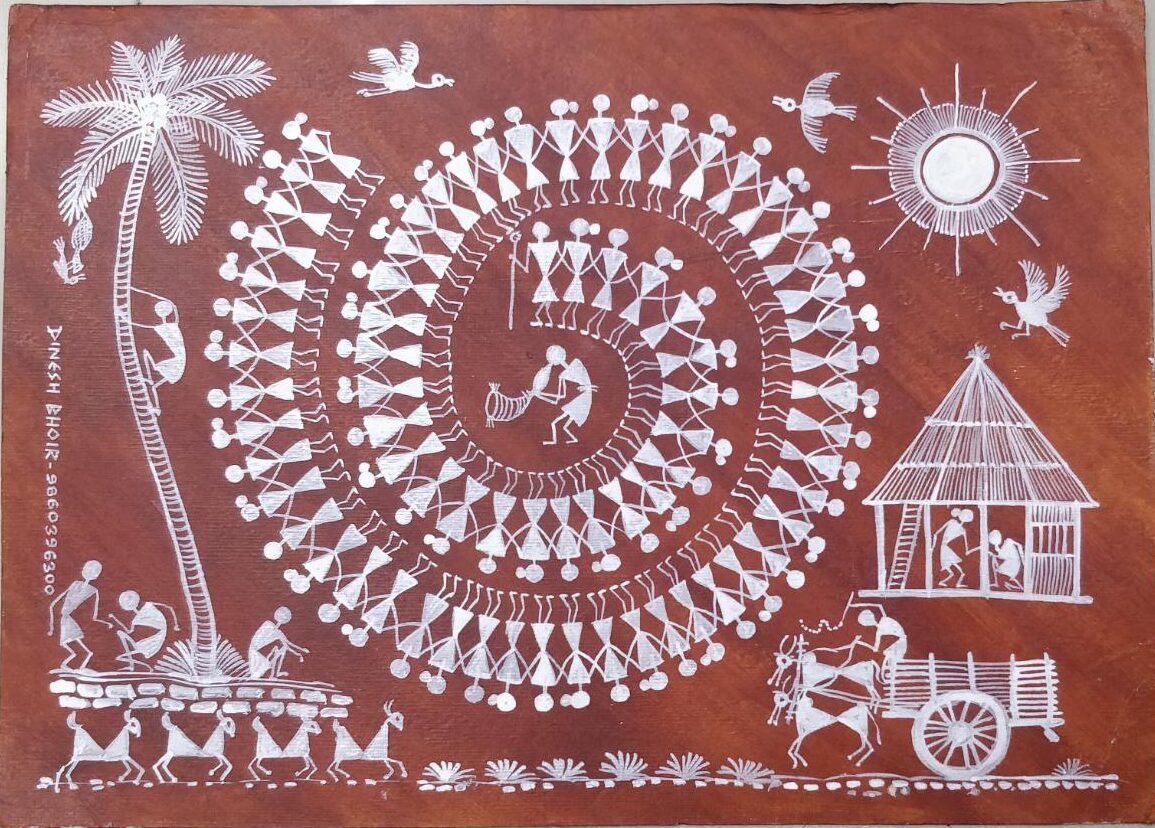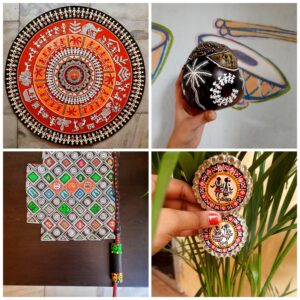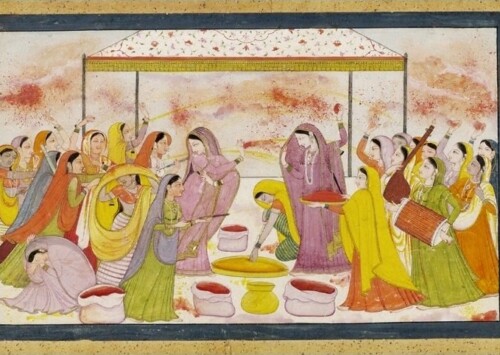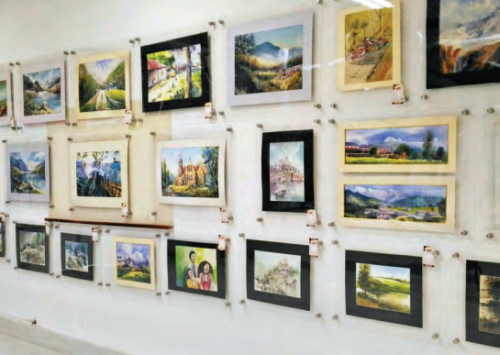Warli Art: Journey from walls of tribal homes to household goods

Warli paintings do not depict any mythological characters or images of deities but portray the circle of life and respect for nature (Photo: Dinesh Bhoir)
Warli paintings take their name from the tribal community on the northern edge of the Sahyadri Range in Maharashtra, primarily in Thane and Palghar districts, with Dahanu and Jawhar at the forefront. The tribal art style dates back to the 10th century AD and has traditionally been used by the tribals to decorate walls of their mud houses on special occasions like harvest and weddings. The most important aspect of the painting is that it doesn’t depict any mythological characters or images of deities but portrays the circle of life and respect for nature, farming and wildlife.
Warli, like other tribal art, has been done with colours developed from natural materials such as rice paste and natural glue which were used to paint on the austere brown mud walls to form a striking contrast. Bamboo sticks served as the artists’ brush.
The uniqueness of Warli paintings lie in the fact that they are always drawn in specific geometric shapes such as circle, triangle and square and each shape symbolizes something distinct. For instance, the triangle symbolises mountain and trees. The square indicates a sacred enclosure for the Mother Goddess, symbolising fertility and the circle represents the sun and moon.
Despite the advent of modern era and heavy industrialisation and urbanisation in the immediate neighbourhood of the areas inhabited by the Warlis, the art form has survived, retaining most of its authentic and traditional practices such as shapes and colours.
“We mostly prefer to use natural products using rice paste with natural glue and do Warli paintings in a traditional way. People come from outside to Dahanu, Jawahar, Wada and other places in Thane and Palghar districts which are well- known for Warli art just to buy the original form of Warli paintings without adding any modern elements,” Dinesh Bhoir, a third-generation Warli artist from Dahanu, about 120 km north of Mumbai, tells Media India Group.
Bhoir began painting at an early age he had seen his grandfather and then his father do the same. Moreover, the art is widely prevalent in the areas around his village and hence he was constantly exposed to it. He says that the artists, who mainly practice the art because it has been in their families for several generations, have stayed with the traditional form, unless customers specifically ask for something different. Also when using paper or cloth as a backdrop for the painting, the artists have to use chemical colours and brushes, instead of bamboo sticks or even bare hands for the painting.
Modern technology helps propagate Warli art
With arrival of modern technology, the art is increasingly gaining recognition and appreciation as several online platforms have emerged which sell the art, opening new markets and creating greater awareness about this niche art. Bhoir says that he sells his paintings on Ayush Adivasi Yuva Shakti, an online platform created exclusively to promote Warli art. Bhoir says through the platform, he as well as other artists have been able to find buyers for their art in different places, in India and overseas. He says that most overseas buyers prefer the traditional form of the art rather than any fusion or modern tinges.
Art Zolo is another platform that helps propagate traditional art, including Warli. It was founded by Mumbai-based Preeti Singhal and Vishal Singhal and it offers an outlet for artists practicing various art forms to find buyers from around the world. “On Art Zolo, we promote only those Warli artists who still use completely natural and traditional methods of painting this art. There are a few such artists as many others have started using modern elements, including chemicals and fusion with other art forms. So, our focus is only on those who still follow the practices of the yesteryears,” Vishal Singhal, co-founder of Art Zolo, tells Media India Group.
Also Read – India Art Festival returns after two years.
Re-imagining the plebian through art.
“The oldest form of tribal Warli art is extremely detail oriented as the artists depict the subjects in great detail. This leads to an art that is far superior in quality. But today people expect fusion of modern elements with the traditional tribal art. So there are not too many buyers for the pure form of Warli art that we sell. On an average, we get only 10 orders in a month from overseas and only a few expects and buys the original form of tribal art” tells Singhal.

Priyanka Sahani makes a fusion art of Mandala and Warli paintings for creative art pieces(Photo: Priyanka Sahani)
Many people prefer Warli paintings because it is simple and clearly depicts the circle life of human. Some artists, especially those outside the area, create their own versions with fusion of other art forms.
“At the time when I lost my father, I was depressed for almost five months, then I decided to reminisce my life through paintings. Warli paintings acted as therapy for me and helped me to continue further. I used to make a fusion art of Mandala and Warli paintings to make more creative and attractive art pieces,” Priyanka Sahani an artist and software developer from Bhubaneshwar tells Media India Group.
Sahani says she gets lost in her own world while creating Warli paintings, which have always motivated her to stay active. She says that the vibrant colours stimulate her heart and mind.
New outlets for an ancient tribal art
The original Warli paintings have been done on the walls of the tribal homes and Bhoir says this practice remains vibrant even today as people paint their walls on all special occasions like marriages, festivals or other social occasions. Many a times when the artists are invited to paint outside their region, they are asked to paint murals on walls or even the walls of the homes of the aficionados from India and overseas. But Bhoir says the paintings are now also mounted on several other household objects like glasses, plates and pieces of decor used indoors as well as garments and canvas.
“I participate every year in the Kala Ghoda Art Festival which is held annually in Mumbai. Warli art has huge demand during this art festival, I make both traditional Warli art and Warli paintings on interior designing products like wall clock, trays, jewelry boxes, name plates, flower vases, key holders and many more objects,” says Bhoir.
Sahani, too, has participated in the iconic Mumbai art fair and says that artists from all over receive a lot of orders for their art during the Kala Ghoda Festival. “Warli art has a huge demand in the exhibition. I too sold many of my creations including Warli paintings. When I saw the demand for traditional paintings on household objects, I began painting Warli art on reusable things,” says Sahani, adding that several of her creations fetch more than INR 5000 each.
Also Read – Shekhawati: World’s largest open air art gallery.
Pablo Picasso: A genius artist.
Dussehra in Delhi: Artisans complain of poor sales of Ravana’s effigies.
The growth of tattoo art: Inking personal stories on a body canvas.
Bhoir says that he remains confident that the art is not threatened with extinction as even today every traditional Warli household has artists who practice this art and consider it close to their heart due to the heritage. Moreover, with rising demand and greater awareness, the Warli art in its traditional form, has a bright future ahead, he says.












